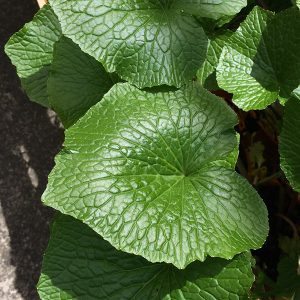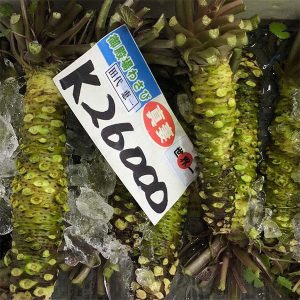
Given a cool shady position Wasabi japonica is the plant that Wasabi paste is made from. It can be grown in the home garden, and is successfully being grown commercially using hydroponics in Australia. Also grown in shaded damp positions for the attractive foliage.
Grown the stem rather than the actual root, it is the above ground stem that is cut once it reaches around 2-3 cm 1 inch in width and 15 cm 6 inches in length. The wasabi flowers are also edible.
How to plant Wasabi.
- In Containers
In a container try a mixture of normal potting soil, vermiculite and perlite.
A position beneath large trees where good shade, and increased humidity go some way to providing the right conditions.
Use a container that is at least 30 cm (12 inches) deep and the same width.
Seedlings need to be around 10 cm (4 inches) apart. - In the ground
In the ground you will need to prepare the soil well. You do need a shaded position, beneath a tree, or use shade cloth around 80% depending on location.
You need to dig the soil over well, add some vermiculite and perlite and some well rotted compost. A little cow manure as well. Dig the soil over to 30 cm (12 inches), mixing in the perlite etc as you go.
How to grow Wasabi – Conditions and Care

- Climate and temperature
Wasabi naturally grows in cool to temperate climates. A temperature range from 46-68°F (8-20°C) is ideal however it will grow in warmer climates as long as it receives adequate water and good shade. Try for a fairly constant temperature : 7C (45F) – 24C (75F) works well, ideally no lower than 10C (50F). Very cold wet winters are not suitable. - Position and Sun
A shaded position is best, 70% – 80% shade cloth can be used. No hot direct sun at all. - Soil
A humus rich free draining sir which is just slightly acidic is recommended. Adding Leaf Mold, aged cow manure and compost is beneficial - Watering
Although wasabi naturally grows by streams, in cultivation it needs drainage, wet soggy soils are not suitable. Regular watering is the key to successful growing. - Planting Depth
Wasabi grows from rhizomes, individual plants should be planted at around 5cm (2 inches) deep and 20 – 30cm (8 – 12) inches apart. - Fertiliser
A slow release organic fertiliser applied each spring will be beneficial for good growth. - Mulch
Each spring after fertilising a good layer of mulch will help keep the soil cool and moist. - Harvesting
The stems can take between 2 and 4 years to be ready to harvest.The best time to harvest is in spring or late summer. The stems should be around 20cm (8 inches) long. - What part of the Wasabi plant do you Eat?
You eat the stem NOT the root…… AND its the lower part of the stem. So the part between the lower leaves and the roots.
Basic Growing Conditions
Wasabi is regarded as difficult to grow, however it’s fairly easy in the right conditions. And these are;
The natural environment is in forested areas near damp areas, so this is what we are trying to recreate, a shaded, moist humid environment. Wasabi naturally grows in river beds in water with a temperature of around 10 – 24 C, although it can be grown in soil, the resulting product is considered to be inferior when used fresh.
Commercially wasabi is grown hydroponically in green houses, this allow the natural growing conditions to be more carefully mimicked.
It grows best in a cool climate, temperatures that range between 7 C and 24C are ideal it will take slightly lower or higher temperatures as long as the plant is in shade and kept moist.
In Australia it is generally grown under shade cloth as it requires a warm humid environment in summer, but not strong direct sun. Plants will take around 2 -3 years to create a root or tuber worth harvesting, however the foliage is also used in salads. A relatively dry winter is required so a raised garden bed and a humus rich soil works well.
Plant will send up offshoots or suckers, break these of to help with root / tuber formation. You can grow it in containers, choose a large pot with a humus rich organic potting mix. Add some extra compost and cow manure if needed.
Propagation and Varieties
Wasabi can be propagated from remove of offsets, from seed and also by tissue culture. Seed is the preferred method by Japanese growers.
With around 20 different varieties, unless you grow from seed only one two varieties will be available, usually the Duruma and Mazuma types.
Other varieties include Takai, Shimane, Midori, Sanpoo, Izawa Daruma and Medeka and Hangen.
Why grow your own Wasabi ?
- First and foremost, to make sure it is Wasabi and not horseradish. Most os the grated and and pastes sold are actually horseradish. It is a related plant, however not the same thing.
- Secondly, it is freshly grated wasabi that is desired by chefs, as well as home cooks. When the stem is grated it releases a chemical that is a sort of defence mechanism. It is natures way of protecting the wasabi plant from fungal and bacterial damage if the stem is damaged. It is this chemical that gives wasabi its unique flavour.
- And finally, look up the 2011 lg Noble prize for chemistry, not the normal chemistry prize but the lg one.
You May Also Like
Wasabi plants are available for sale from the following suppliers
470 Monbulk-Silvan Road Monbulk VIC 3793
"Guaranteed mail order flowering bulbs, perennials, roses, trees, landscaping plants, garden accessories and community fundraising Austra lia-wide."
www.gardenexpress.com.au
In Victoria Try
Mt Evelyn Garden Centre – ph 03 97361132
126 York Rd Mt Evelyn

